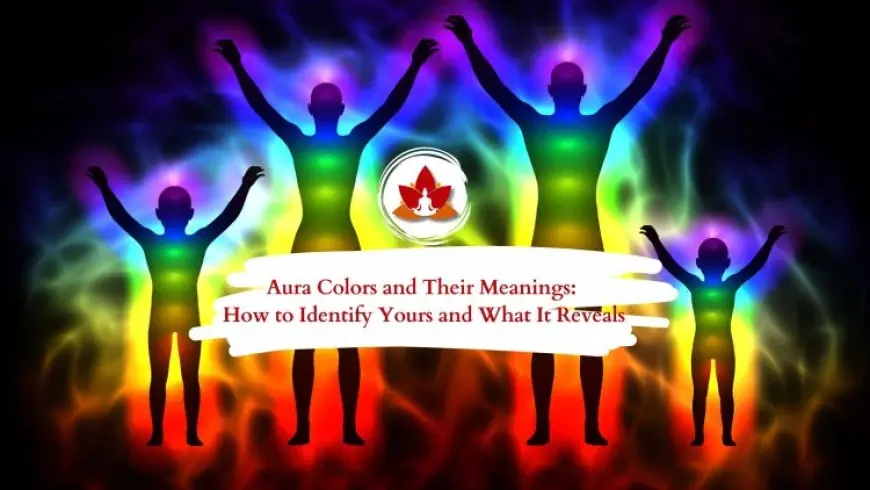Aura Color Meaning: What Your Energy Field Says About You
Understanding aura color meanings can offer powerful insights into a person’s emotions, energy, and spiritual state. Each aura color—whether vibrant like red or serene like blue—reflects a unique aspect of an individual's inner world. By learning to interpret these colors, you can gain a deeper awareness of yourself and those around you.

The human aura is a fascinating and mystical concept that has intrigued spiritual seekers, healers, and energy workers for centuries. Often described as a subtle, colorful electromagnetic field that surrounds the body, the aura is said to reflect a person’s emotional, mental, spiritual, and even physical state. At the core of aura interpretation lies the concept of aura color meaning—the idea that the colors seen in an individual's aura can provide deep insight into their personality, health, and energetic condition.
In this guide, we’ll explore what aura colors are, how to interpret them, and what each hue may signify about you or those around you.
What Is an Aura?
An aura is believed to be an energy field that radiates from all living beings. While invisible to most, some sensitive individuals, such as psychics or energy healers, claim to see or sense this field. Auras can appear as bands or layers of color around the body, especially the head and heart area.
Your aura is not static; it changes based on your emotions, thoughts, health, and spiritual state. Just like your mood or mindset, your aura color can shift from moment to moment, but most people have a dominant or “base” aura color that reflects their core personality or energy type.
How Do People See Aura Colors?
Some people claim to be able to see auras naturally, while others develop this ability through training and practice. Techniques used include:
-
Aura photography (Kirlian photography): Special cameras can allegedly capture your aura's image.
-
Meditation and visualization: Some energy workers use meditative states to intuitively read aura colors.
-
Muscle testing or pendulum work: Energetic testing methods used by practitioners to interpret aura hues.
Even if you can’t see your aura, you may still be able to sense its color through introspection, emotional awareness, or feedback from someone trained in aura reading.
The Meaning of Each Aura Color
Let’s explore the aura color meaning behind the most commonly observed hues:
1. Red Aura Meaning
-
Key Traits: Passionate, grounded, energetic, ambitious
-
Chakra Connection: Root Chakra
-
Positive Aspects: Vitality, courage, physical strength, drive
-
Challenges: Anger, aggression, impulsiveness
A red aura reflects strong willpower, physical energy, and a drive to achieve. Those with a red aura are often leaders or go-getters but may struggle with patience or temper control.
2. Orange Aura Meaning
-
Key Traits: Creative, sociable, adventurous
-
Chakra Connection: Sacral Chakra
-
Positive Aspects: Innovation, joy, intimacy
-
Challenges: Restlessness, overindulgence
An orange aura indicates creativity and a zest for life. These individuals thrive in social situations and are often artists, performers, or entrepreneurs.
3. Yellow Aura Meaning
-
Key Traits: Optimistic, intelligent, curious
-
Chakra Connection: Solar Plexus Chakra
-
Positive Aspects: Confidence, mental clarity, cheerfulness
-
Challenges: Overthinking, anxiety, perfectionism
People with yellow auras are natural learners and thinkers. They radiate positivity and often inspire others but need to watch for mental burnout or self-doubt.
4. Green Aura Meaning
-
Key Traits: Compassionate, balanced, nature-loving
-
Chakra Connection: Heart Chakra
-
Positive Aspects: Healing, love, growth
-
Challenges: Jealousy, emotional sensitivity
A green aura reflects a healing and nurturing energy. These individuals often become caregivers, counselors, or teachers. When imbalanced, their generous nature can lead to emotional exhaustion.
5. Blue Aura Meaning
-
Key Traits: Calm, intuitive, communicative
-
Chakra Connection: Throat Chakra
-
Positive Aspects: Honesty, inner peace, diplomacy
-
Challenges: Repression, passivity
A blue aura suggests a deeply spiritual and expressive individual. Often empathetic, they seek harmony and truth, though they may avoid conflict even when necessary.
6. Indigo Aura Meaning
-
Key Traits: Wise, introspective, psychic
-
Chakra Connection: Third Eye Chakra
-
Positive Aspects: Intuition, insight, depth
-
Challenges: Isolation, overwhelm from spiritual sensitivity
An indigo aura signifies a strong inner knowing and a connection to higher consciousness. These individuals often explore metaphysical topics and may work in healing or guidance roles.
7. Violet or Purple Aura Meaning
-
Key Traits: Spiritual, visionary, idealistic
-
Chakra Connection: Crown Chakra
-
Positive Aspects: Enlightenment, creativity, universal love
-
Challenges: Detachment, escapism
A violet aura is rare and deeply spiritual. These individuals are drawn to higher ideals and may feel like old souls. However, they must ground themselves to avoid losing touch with reality.
8. White Aura Meaning
-
Key Traits: Pure, transcendent, balanced
-
Chakra Connection: Crown and entire energy system
-
Positive Aspects: Enlightenment, clarity, oneness
-
Challenges: Fragility, aloofness
White auras often belong to individuals with advanced spiritual awareness. This is often associated with healers or those undergoing spiritual awakening.
9. Black or Dark Aura Meaning
-
Key Traits: Blocked energy, pain, trauma
-
Not a Chakra Color: Often indicates energetic congestion
-
Interpretation: Not evil, but signals a need for healing
Contrary to popular belief, a black aura doesn’t mean someone is "bad" or "evil." It often reflects unresolved trauma, suppressed emotions, or energetic blockages.
Can Aura Colors Change?
Absolutely. Aura colors are fluid and reflect your current energetic state. For example, someone normally calm and grounded (green aura) might display red during a moment of anger or stress. Major life events, emotional healing, or spiritual growth can all lead to shifts in your aura.
How to Cleanse or Strengthen Your Aura
Maintaining a strong, vibrant aura helps protect you energetically and keep your spirit balanced. Here are a few ways to cleanse or enhance your aura:
-
Meditation and grounding exercises
-
Energy healing (Reiki, sound baths, crystal therapy)
-
Spending time in nature
-
Smudging with sage or palo santo
-
Using aura sprays or essential oils
-
Journaling and emotional processing
Regular self-care and energetic hygiene can help you maintain a healthy aura and better understand your aura color meaning over time.
Final Thoughts
Understanding aura color meaning is a powerful tool for personal growth, spiritual development, and emotional healing. Whether you're a believer in energy fields or simply curious about what your aura could reveal, interpreting these colors can offer valuable insights into your life’s journey.
As with any metaphysical concept, take what resonates with you and explore it with an open heart and mind. Your aura is a beautiful reflection of your inner world—and by understanding it, you deepen your connection to yourself and the universe around you.
What's Your Reaction?
 Like
0
Like
0
 Dislike
0
Dislike
0
 Love
0
Love
0
 Funny
0
Funny
0
 Angry
0
Angry
0
 Sad
0
Sad
0
 Wow
0
Wow
0

















































